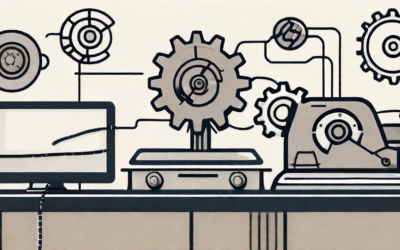In today’s fast-paced work environment, maximizing workflow efficiency is crucial for businesses to stay competitive. An efficient workflow ensures that tasks are completed in a timely manner, minimizing bottlenecks and increasing productivity. In this article, we will explore 10 proven strategies for boosting workflow efficiency and achieving optimal productivity.
Understanding Workflow Efficiency
Efficiency is a crucial aspect of any successful business. It is the driving force behind productivity and effectiveness, allowing employees to focus on tasks that add value and contribute to the overall goals of the organization. When workflows are streamlined and optimized, employees can work more effectively, resulting in higher quality output and increased customer satisfaction.
Efficient workflows are like well-oiled machines, seamlessly moving from one task to another with minimal friction. They ensure that every step in a process is executed smoothly, eliminating unnecessary delays and bottlenecks. This not only saves time but also reduces costs and improves resource allocation.
The Importance of Efficient Workflows
Efficient workflows play a pivotal role in the success of a business. They enable teams to work cohesively, ensuring that everyone is on the same page and working towards a common goal. By eliminating confusion and ambiguity, efficient workflows promote collaboration and foster a positive work environment.
Moreover, efficient workflows empower employees to make the most of their skills and expertise. When processes are well-defined and optimized, employees can focus on tasks that align with their strengths, resulting in higher job satisfaction and increased productivity.
Key Components of Workflow Efficiency
Workflow efficiency encompasses various elements that contribute to its overall effectiveness. These include clear communication channels, well-defined roles and responsibilities, efficient use of technology, and streamlined processes.
Clear communication channels are essential for efficient workflows. When information flows seamlessly between team members, it reduces the chances of miscommunication and ensures that everyone is on the same page. Whether it’s through regular meetings, email updates, or project management tools, effective communication is the cornerstone of a well-functioning workflow.
Well-defined roles and responsibilities are another critical component of workflow efficiency. When everyone knows their specific tasks and responsibilities, it eliminates confusion and duplication of efforts. Clearly defined roles also promote accountability, as individuals are aware of their responsibilities and can be held responsible for their performance.
Efficient use of technology can significantly enhance workflow efficiency. By leveraging the right tools and software, businesses can automate repetitive tasks, streamline processes, and improve overall productivity. From project management software to collaboration platforms, technology plays a vital role in optimizing workflows and maximizing efficiency.
Streamlined processes are the backbone of efficient workflows. By analyzing existing processes and identifying areas for improvement, businesses can eliminate unnecessary steps, reduce bottlenecks, and enhance overall efficiency. This may involve reengineering processes, implementing new technologies, or adopting best practices from industry leaders.
In conclusion, understanding workflow efficiency is essential for businesses looking to maximize productivity and achieve their goals. By focusing on clear communication, well-defined roles, efficient use of technology, and streamlined processes, organizations can create a work environment that fosters collaboration, innovation, and success.
Analyzing Your Current Workflow
When it comes to optimizing your workflow, it’s crucial to start by analyzing your current processes. By taking a closer look at each step of the workflow, you can identify bottlenecks and inefficiencies that may be hindering productivity and causing delays. This thorough examination allows you to gain a comprehensive understanding of your workflow and pinpoint areas that require improvement.
Identifying Bottlenecks and Inefficiencies
During the analysis phase, it’s important to pay attention to any bottlenecks or inefficiencies that may be present in your workflow. These bottlenecks can occur when certain steps in the process take longer than necessary or when there is a lack of coordination between different teams or departments. By identifying these bottlenecks, you can focus your efforts on finding solutions to streamline the workflow and eliminate any unnecessary delays.
Furthermore, analyzing your workflow helps you identify inefficiencies that may be causing errors or rework. By closely examining each task and its dependencies, you can identify areas where mistakes are more likely to occur. This insight allows you to implement strategies to minimize errors and improve the overall quality of your work.
Tools for Workflow Analysis
Fortunately, there are various tools available to assist businesses in analyzing their workflows effectively. One popular tool is process mapping, which involves creating visual representations of the workflow using flowcharts or swimlane diagrams. These diagrams provide a clear and concise overview of the sequential flow of tasks, making it easier to identify areas that need improvement.
Another useful tool is time tracking software, which allows you to monitor the time spent on each task. By tracking the time spent on different activities, you can identify tasks that are taking longer than expected or consuming excessive resources. This information enables you to prioritize tasks, allocate resources more efficiently, and identify opportunities for automation or delegation.
Additionally, project management software can play a crucial role in workflow analysis. These tools provide a centralized platform for tracking the progress of tasks, assigning responsibilities, and setting deadlines. By using project management software, you can ensure that tasks are completed on time and easily identify any bottlenecks or delays in the workflow.
In conclusion, analyzing your current workflow is a vital step in optimizing your processes. By identifying bottlenecks, inefficiencies, and areas for improvement, you can implement strategies to enhance productivity, reduce errors, and ultimately achieve better results. Utilizing tools such as process mapping, time tracking software, and project management software can greatly facilitate the analysis process and help you make informed decisions to streamline your workflow.
Proven Strategies for Boosting Workflow Efficiency
Efficiency is a key factor in the success of any organization. By optimizing workflow processes, businesses can save time, reduce costs, and increase productivity. In this article, we will explore some proven strategies for boosting workflow efficiency and achieving optimal results.
Prioritizing Tasks for Maximum Impact
One effective strategy for boosting workflow efficiency is prioritizing tasks based on their impact. By focusing on high-priority tasks that align with the organization’s goals, employees can maximize their productivity and contribute to overall success. This involves setting clear objectives, breaking tasks into manageable chunks, and allocating resources accordingly.
For example, a marketing team may prioritize tasks related to a new product launch, such as creating promotional materials, conducting market research, and developing a marketing strategy. By prioritizing these tasks, the team can ensure that their efforts are focused on activities that will have the greatest impact on the success of the product.
Implementing Automation in Your Workflow
Automation is a powerful tool for enhancing workflow efficiency. By automating repetitive tasks, businesses can save time and resources. This can be achieved through the use of software applications, robotic process automation, or workflow management systems. By automating tasks such as data entry, report generation, or email notifications, employees can focus on more strategic and high-value activities.
For instance, a customer service team can use automation to streamline their workflow by implementing a chatbot to handle common customer inquiries. This frees up the team’s time to focus on more complex customer issues, improving response times and overall customer satisfaction.
The Role of Effective Communication in Workflow Efficiency
Effective communication plays a vital role in workflow efficiency. Clear and timely communication ensures that everyone involved in the workflow is on the same page and understands their roles and responsibilities. This can be achieved through regular team meetings, project management software, or collaboration tools. By fostering open communication channels, businesses can minimize misunderstandings and streamline the flow of information.
For example, a remote team can use communication tools like video conferencing or instant messaging to stay connected and collaborate effectively. Regular check-ins and status updates can help team members stay informed about project progress and address any issues or concerns in a timely manner.
Streamlining Processes for Better Efficiency
Streamlining processes is essential for achieving workflow efficiency. Businesses should regularly review their processes and identify areas for improvement. This may involve eliminating unnecessary steps, simplifying complex procedures, or reorganizing tasks to minimize bottlenecks. By continuously optimizing processes, businesses can reduce errors, improve productivity, and enhance overall efficiency.
For instance, a manufacturing company can streamline their production process by implementing lean manufacturing principles. By eliminating waste, standardizing processes, and improving workflow layouts, the company can reduce lead times, improve quality, and increase overall efficiency.
Leveraging Technology for Optimal Workflow
Technology can greatly enhance workflow efficiency. Businesses should leverage technology tools and software applications to automate tasks, streamline processes, and improve collaboration. Project management software, cloud-based storage systems, and communication tools can all contribute to a more efficient workflow. However, it’s important to choose the right technology solutions that align with the organization’s specific needs and goals.
For example, a software development team can use version control systems and collaboration tools to streamline their workflow. By using these tools, team members can easily track changes, collaborate on code, and ensure that everyone is working on the latest version of the software.
In conclusion, boosting workflow efficiency is crucial for the success of any organization. By prioritizing tasks, implementing automation, fostering effective communication, streamlining processes, and leveraging technology, businesses can optimize their workflow and achieve optimal results.
Maintaining and Improving Workflow Efficiency
Regularly Reviewing and Updating Your Workflow
Workflow efficiency is not a one-time fix but an ongoing process. It’s important to regularly review and update your workflow to ensure that it remains optimized. This involves gathering feedback from employees, monitoring key metrics, and adapting to changes in the business environment. By staying proactive and continually improving, businesses can maintain a high level of workflow efficiency.
Training and Development for Continuous Improvement
Investing in training and development is crucial for continuous improvement in workflow efficiency. By providing employees with the necessary skills and knowledge, businesses can empower them to work more efficiently. Training can be focused on specific technology tools, process improvement methodologies, or soft skills such as time management and communication. By supporting employee growth, businesses can foster a culture of continuous improvement.
Measuring Workflow Efficiency: Key Metrics
Measuring workflow efficiency is essential to determine the effectiveness of implemented strategies. Key metrics can include cycle time, error rates, customer satisfaction, or productivity levels. By regularly tracking these metrics, businesses can identify trends, pinpoint areas for improvement, and make data-driven decisions. This allows for continuous refinement and optimization of workflow efficiency.
Boosting workflow efficiency is an ongoing journey that requires commitment and dedication. By understanding the importance of efficient workflows, analyzing current processes, and implementing proven strategies, businesses can achieve optimal productivity and drive success. Remember, a well-optimized workflow not only maximizes productivity but also contributes to the overall growth and profitability of the organization. Start implementing these strategies today and reap the benefits of a highly efficient workflow.




